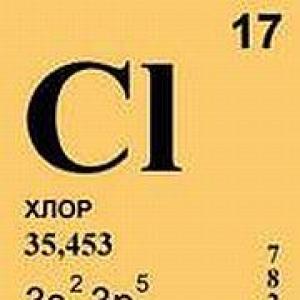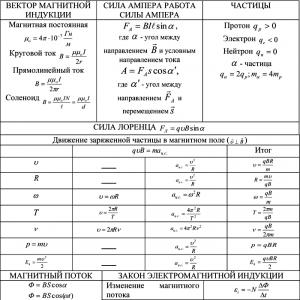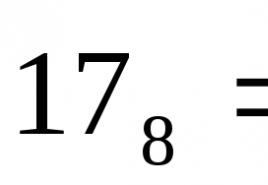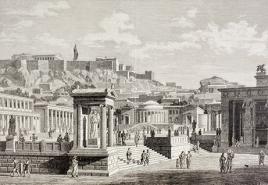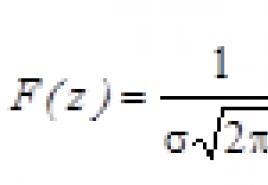A brief history of anatomy. History of anatomy
Until the beginning of the 5th century BC. e., in the Ionian period, in Ancient Greece, knowledge about the structure of humans and animals was approximately at the level of knowledge of the peoples of the East. The ancient Greeks gained knowledge from their knowledge of animal anatomy, and in addition, they were probably allowed to dissect criminals. Euripides described the portal vein, Anaxagoras - the lateral ventricles of the brain, Aristophanes - the two membranes of the brain, Empedocles - the ear labyrinth, Alcmaeon - the optic nerve and auditory tube, Diogenes - the aorta, carotid artery, jugular vein, left ventricle of the heart. In the VIII-VI centuries BC. e. The founders of Greek philosophy - Thales, Anaximander, Anaximenes and Heraclitus - put forward the idea of natural self-development of the world. According to Thales, the source of life is water, according to Anaximander - moisture, earth and heat of the sun, according to Anaximenes - air, according to Heraclitus - fire. Heraclitus pointed out that every change in the world is the result of struggle. Although these philosophers laid the foundations for a dialectical understanding of the development of nature, they could not understand the evolution of living things. The doctrine of evolution was formed only in the 19th century.
The founder of anatomy and physiology in Greece is considered to be Alcmaeon of Croton, who was the first to write a book on anatomy at the end of the 6th - beginning of the 5th century BC. e. He dissected the corpses of animals and pointed out that the brain is the center of sensations and thinking, understood the importance of nerves for the sensory organs, was the first to create a theory of sensations and showed that animals have sensations, and humans not only feel, but also think. This feature distinguishes humans from animals. According to Alcmaeon, disease consists of an imbalance of wet or dry, warm or cold, bitter or sweet, etc. Recognizing the materiality of the living, he believed in the materiality of the soul.
The foundations of spontaneous materialism, laid down in philosophy by Ionian natural philosophers, were developed in Ancient Greece by Leucippus (5th century BC), Anaxagoras (500-428 BC) and Empedocles (492-432 BC). e.). They considered the structure and origin of the world from the standpoint of the ancient atomic theory, which was based on the fact that all plants and animals consist of small particles of “seeds”. For example, Anaxagoras did not distinguish between animals and plants based on their structure and functions. He believed that plants and animals are capable of thinking, feeling, grieving, rejoicing and thinking; man is distinguished by the fact that he has hands. In the process of digestion, according to Anaxagoras, particles of muscles combine with muscles, blood with blood, hearts with heart, etc. The teaching of atomists played a certain role in creating the idea of the natural origin of living beings, which was very progressive and contrary to religious teachings about the divine origin of man. This teaching was continued by Democritus (460-370 BC), who believed that atoms are eternal and unchangeable, not created by anyone and cannot be destroyed, life is a connection of atoms, death is separation. According to Democritus, all living beings originated from silt, which, as a result of decay under the influence of the sun, gave rise to living beings. The embryo develops from a seed containing particles of all parts of the body. This contradicted the prevailing belief that the seed (sex cells) is a product of the brain.
Hippocrates (460-377 BC)
A contemporary of Democritus was Hippocrates (460-377 BC), the greatest physician of the ancient world, whose basic ideas are also used in modern medicine. Hippocrates was the son of a doctor (in those days the profession of a doctor was inherited). Already at the age of 20, Hippocrates was famous as a doctor. We can judge Hippocrates' contribution to medicine from the books compiled 100 years after his death into the so-called Hippocratic collection. This collection represents a body of medical knowledge from the pre-Aristotelian period and is called Hippocratic medicine. Hippocrates was a practical doctor, and his materialism was expressed in the fact that, while rejecting the intervention of supernatural forces in the occurrence and development of illness, he recognized observation and experience. Hippocrates attached importance to environmental factors in the development of the disease, taking into account the age and lifestyle of the patient.
The principle of the Hippocratics was that it is necessary to treat not the disease, but the patient. The philosophy of life, according to Hippocrates, was built on fire, water, air, earth and their properties (warm, cold, wet, dry). He created the doctrine of liquids that are included in certain proportions in the composition of the body. Hippocrates believed that if blood, mucus, yellow bile and black bile are mixed quantitatively and qualitatively correctly, then the body will be healthy. This teaching was very progressive for that time.
Being an excellent doctor, Hippocrates naturally sought to understand the human structure. He and his students had a greater understanding of anatomy than the doctors of the countries of the Ancient East, but there is no doubt that Hippocrates himself did not know enough anatomy. Books from the time of Hippocrates were the best to explain the structure of bones, probably because they were often found weathered on the surface of the soil. The bones of the skull, vertebrae and ribs were described in some detail. The first vertebra was not yet known. They also knew little about muscles, which were summarized by the concept of “meat.” In the time of Hippocrates, many tendons and nerves were not identified, but the auditory, optic, trigeminal and vagus cephalic nerves, brachial, intercostal and sciatic spinal nerves were distinguished. Among the internal organs, the stomach and intestines (as one organ), liver and gallbladder, spleen, kidney, bladder, lymphatic and mammary glands were known. The brain was mistaken for a gland that produces fluid and semen, but there were already guesses that the brain also performed mental functions.
The Hippocrats believed that the heart had ventricles, atria, valves and blood vessels. The inhaled air serves to cool the heart. There were vague ideas about the movement of blood. Three membranes were described in the eyeball, in addition to the retina. The vitreous was taken to be the visual fluid. If accurate anatomical data is found in the collection of Hippocrates, then they were obtained not by Hippocrates, but by other authors. There are suggestions that even the doctor's oath dates back to an older period than the life of Hippocrates. The idea of embryonic development of humans and animals was based on the views of Democritus.
In the IV-III centuries BC. e. in contrast to the materialistic ideas of Democritus and Hippocrates, the idealistic teaching of Plato (429-347 BC) arose, explaining the material world as an imperfect reflection of ideas comprehended by the mind. Life on Earth arose with the advent of man, created by God. The diversity of the animal world is the result of deviations from the usual development of people. According to Plato, the brain is the seat of the immortal part of the soul, and its mortal parts live in the heart and stomach. The doctrine of the three souls had a certain influence on the views of Aristotle (384-322 BC), who was a student of Plato for 20 years.
Aristotle is a major scientist of Ancient Greece, educator of Alexander the Great, creator of the huge work “History of Animals.” Of his 400 works devoted to various branches of knowledge, 4 large and 11 small treatises contained systematic data on zoology and botany of that time. Aristotle described the nerves of the brain in more detail than in the Hippocratic period. In his philosophical judgments, he confused materialistic and idealistic ideas about the world. For example, passive matter contains an active form, which has a divine origin. Aristotle, like his teacher Plato, distinguished the soul into three types. Plants have only a nourishing soul, animals are endowed with a nourishing and feeling souls, and man, except for two, has his own rational soul. Regarding anatomical data, he was confident that man has internal organs similar to animals. Aristotle did not agree with those scientists who considered the diaphragm to be the center of thinking, and attributed to it the role of a partition between the chest and abdomen. The anatomical data he described were obtained from dissection of animals or borrowed from other authors, and sometimes fantastic fabrications were cited, especially when explaining the purpose of organs. In his work “The Ladder of Nature,” Aristotle made an attempt to compare different animals and establish not only their differences, but also their similarities. He made an important materialistic conclusion that every animal comes from an animal.
The first stages of the development of anatomy included a description of the organs of the human body, which were observed during autopsies of corpses.
Stage I Descriptive Anatomy This method dominated until the 20th century.
Stage II Systematic anatomy– the human body began to be studied according to organ systems united by a common function, structure and development.
Stage III Topographic anatomy (or surgical era)– during surgical interventions, surgeons had to accurately determine the location of the organ in the human body.
Stage IV Plastic anatomy – shapes and convexities of the human body.
Stage V Functional anatomy – associated with systematic.
Stage VI Age anatomy – studies a person at different periods of life.
VII stage Comparative anatomy– compares the human body with different animals.
VIII stage Archaeological anatomy– studies a person in different eras of life.
5. Ancient anatomists:
Medicine arose before information appeared about the structure and function of the organs of the body of animals and humans.
The autopsy of the body of animals was carried out during sacrifices and food preparation, and of humans - during embalming.
Hippocrates– 460l. BC. - the time of the birth of anatomy.
He discovered 4 types of liquid - blood, mucus, bile, black bile.
Errors – arteries contain air, brain produces semen.
Plato– (427-347 BC) revealed that the brain of vertebrates develops in the anterior sections of the spinal cord.
Errors – 3 souls (brain, liver, heart – there are 3 souls here).
Aristotle– The main organ in the body is the heart. Opened the tendon and nerves.
The 16th century described 7 pairs of cranial nerves. Wrote works “On the parts of the human body.”
Avicenna– wrote the book “The Canon of Medical Science.”
Andras Vesalius– 1514-1564 wrote a work in 7 books “On the structure of the human body.”
Harvey– (1578-1657) systemic circulation, anastomoses – junctions of large vessels.
Servet- (1511-1553) pulmonary circulation.
Azelli- (1591-1626) described the lymphatic vessels of the mesentery of the small intestine.
In 1725- The Academy of Sciences was opened in St. Petersburg.
In 1795– University in Moscow.
Lomonosov- discovered the law of conservation of matter, formulated a three-component theory of color vision, and gave the first classification of taste sensations.
Schwann- (1810-1882) discovered the cell, in 1839 created the cellular theory of the structure of organisms.
Pirogov- was a military field doctor, opened 12 thousand corpses. He applied anesthesia, splints, and opened the fascia.
Lesgaft– used the radiography method, the founder of physical development.
Vorobiev– created an atlas on the use of embalming (Lenin’s corpse).
Sechenov– discovered the reflexes of the brain.
Pavlov– digestive system, nervous system, 2nd signaling system (the role of the word).
6. Anatomical nomenclature:
See Appendix No. 1.
Human anatomy is the science of the origin and development, forms and structure of the human body. Anatomy studies the external forms and proportions of the human body and its parts, individual organs, their design, and microscopic structure. The tasks of anatomy include the study of the main stages of human development in the process of evolution, the structural features of the body and individual organs at various age periods, and the formation of the human body in environmental conditions.
Modern science considers the structure of the human body from the standpoint of dialectical materialism. Human anatomy should be studied taking into account the functions of each organ and organ system. “...Form and function mutually determine each other.” The features of the form and structure of the human body cannot be understood without analyzing the functions, just as it is impossible to imagine the features of the function of any organ without understanding its structure. The human body consists of a large number of organs, a huge number cells, but this is not the sum of individual parts, but a single harmonious living organism... Therefore, it is impossible to consider organs without interconnection with each other, without the unifying role of the nervous and vascular systems.
Knowledge of anatomy in the medical education system is undeniable. Moscow University professor E. O. Mukhin (1766-1850) wrote that “a doctor who is not an anatomist is not only not useful, but also harmful.” Poorly knowing the structure of the human body, the doctor can cause harm to the patient instead of benefiting him. That is why, before you begin to comprehend clinical disciplines, it is necessary to study anatomy. Anatomy and physiology form the foundation of medical education and medical science. “Without anatomy, there is no therapy, no surgery, but only signs and prejudice. ki,” wrote the famous obstetrician-gynecologist A.P. Gubarev (1855-1931).
2. Historical stages in the development of anatomy.
Stages of development of anatomy as a science
To understand the state and prospects for the development of any science, including anatomy, it is necessary to know the main stages of its formation. The history of anatomy, which is part of the history of medicine, is the history of the struggle between materialistic ideas about the structure of the human body and idealistic and dogmatic ones. The desire to obtain new, more accurate information about the structure of the human body, to know “oneself” for many centuries met resistance from the reactionary secular authorities and the church.
The history of the development of anatomy in 5 periods:
1) Initial: covers the 5th century BC Scientists: Heraclitus. Hippocrates (20 volumes).
2) Scientific development: absorbs from the IV century BC. and until the 15th century AD. Scientists of the 4th century: Aristotle (Organ system. Theory of the development of the organism). In the II century BC: Galen. (Affirms that the heart, brain, liver are the main organs).
3) Renaissance period: XVI century - and the first half of the XVII century. Scientists: Harvey - the doctrine of blood circulation. Fallopian - studies the structure of the genital organs. Eustachius - respiratory organs and hearing aid. Leonardo Da Vinci - images of animals and humans.
4) Microscopic period: second half of the 17th and 18th centuries. Scientists: Malpighius - the study of blood vessels.
5) Comparative embryonic period: XIX-XX centuries. - today's time. Scientists: Cuvier's theory of embryonic development.
Created: 2013-11-19 Updated: 0000-00-00
Introduction to anatomy. Historical sketch of the development of anatomy.
Definitions, subject and meaning of anatomy. Varieties of anatomy. History of anatomy. Ancient anatomy. A brief historical sketch of the development of anatomy. Key points in the history of anatomy. Development of anatomy among the ancient Egyptians, Greeks, Romans, in the countries of the East and Central Asia, during the Renaissance, in Russia

Development of anatomy during the Renaissance
In the second millennium, the development of cities, trade, and culture provided a new impetus for the development of medicine. Medical schools are emerging. One of the first schools was opened in Salerno, near Naples, where autopsies on human corpses were allowed once every 5 years. The first universities open. Since the 13th century, medical faculties have been established at universities. In the XIV–XV centuries. In them, 1-2 corpses per year began to be dissected for demonstration to students. In the XVI–XVII centuries. public dissections of human corpses were performed, for which special premises were created - anatomical theaters (for example, in Padua, 1594, Bologna, 1637).
(1452 - 1519), having opened 30 corpses, made numerous sketches of bones, muscles, heart and other organs and compiled written explanations for these drawings. He studied the shapes and proportions of the human body, proposed a classification of muscles, and explained their function from the point of view of the laws of mechanics. He is the founder of plastic anatomy.

(1514 - 1564), based on his own observations made during autopsies of corpses, wrote the work " About the structure of the human body
" (De humani corporis fabrica
), published in Basel in 1543. Where Vesalius systematically and quite accurately described human anatomy and pointed out Galen’s anatomical errors. The research and innovative work of Vesalius predetermined the further progressive development of anatomy. His students and followers in the 16th – 17th centuries. many anatomical discoveries, clarifications, and corrections were made; Many organs of the human body were described in detail.

(1578 - 1657), in 1628 the book " Anatomical study on the movement of the heart and blood in animals ", in which he provided evidence of the movement of blood through the vessels of the systemic circulation (blood moves through a closed circle of vessels, passing from arteries to veins through the smallest tubes).

(1638 – 1731), the Dutch anatomist improved the method of embalming corpses, injecting colored masses into blood vessels, and created a large collection of anatomical preparations for that time, including preparations demonstrating malformations and anomalies. During one of his visits to Holland, Peter I purchased from F. Ruish more than 1,500 preparations for the famous St. Petersburg Kunstkamera.

(1628 – 1694), (photo by Malpighi) discovered blood capillaries (anastomoses) in 1661 using a microscope.
Development of anatomy in Russia

(1748 – 1795), studied the structure of the kidneys, proved the absence of “intermediate spaces” and the presence of a direct connection between arterial and venous capillaries. Thus, Shumlyansky was the first to prove that the circulatory system is closed.
 (1810-1881). Occupies a special place in the history of anatomy and surgery. Having begun his medical career at Moscow University, he continued his studies in anatomy and surgery at Dorpat (now Tartu) University. On the initiative of N.I. Pirogov, an anatomical institute was created at the Medical-Surgical Academy, and the system of anatomical training of doctors was improved. N.I. Pirogov attached great importance to accurate knowledge of anatomy. N.I. Pirogov’s great merit as an anatomist is the discovery and development of an original method for studying the human body using cuts from frozen corpses in order to study the relationships of organs with each other and with the skeleton. N. I. Pirogov summarized the results of many years of work in the book " Topographic anatomy illustrated by sections drawn through the frozen human body in three directions"(1852 - 1859). N.I. Pirogov studied the fascia and cellular spaces in the human body, published a work" Surgical anatomy of arterial trunks and fascia
"(1838). He owns" A complete course of applied anatomy of the human body
"(1843 - 1848) and many other studies on anatomy and surgery. The lingual triangle - a section of the upper lateral part of the neck, the aponeurosis of the biceps brachii muscle (Pirogov's fascia), the lymph node located in the deep ring of the femoral canal, and other anatomical formations.
(1810-1881). Occupies a special place in the history of anatomy and surgery. Having begun his medical career at Moscow University, he continued his studies in anatomy and surgery at Dorpat (now Tartu) University. On the initiative of N.I. Pirogov, an anatomical institute was created at the Medical-Surgical Academy, and the system of anatomical training of doctors was improved. N.I. Pirogov attached great importance to accurate knowledge of anatomy. N.I. Pirogov’s great merit as an anatomist is the discovery and development of an original method for studying the human body using cuts from frozen corpses in order to study the relationships of organs with each other and with the skeleton. N. I. Pirogov summarized the results of many years of work in the book " Topographic anatomy illustrated by sections drawn through the frozen human body in three directions"(1852 - 1859). N.I. Pirogov studied the fascia and cellular spaces in the human body, published a work" Surgical anatomy of arterial trunks and fascia
"(1838). He owns" A complete course of applied anatomy of the human body
"(1843 - 1848) and many other studies on anatomy and surgery. The lingual triangle - a section of the upper lateral part of the neck, the aponeurosis of the biceps brachii muscle (Pirogov's fascia), the lymph node located in the deep ring of the femoral canal, and other anatomical formations.
 (1837 – 1909). An outstanding researcher in the field of functional anatomy and the theory of physical education. Author of the fundamental work " Basics of theoretical anatomy
". P. F. Lesgaft is the founder of theoretical anatomy in Russia. He described the patterns of restructuring of bone substance under the influence of muscle traction, formulated the principles of the development of blood vessels and their relationships depending on the structure and function of organs, showed the importance of anastomoses between arteries in the blood supply to organs and body parts.
(1837 – 1909). An outstanding researcher in the field of functional anatomy and the theory of physical education. Author of the fundamental work " Basics of theoretical anatomy
". P. F. Lesgaft is the founder of theoretical anatomy in Russia. He described the patterns of restructuring of bone substance under the influence of muscle traction, formulated the principles of the development of blood vessels and their relationships depending on the structure and function of organs, showed the importance of anastomoses between arteries in the blood supply to organs and body parts.

(1834 - 1894). A well-known representative of the Kyiv anatomical school, who studied the structure of the adrenal medulla, as well as the cerebral cortex and described the large pyramidal neuron (Betz cell).

(1872 – 1954), founder of the Leningrad School of Anatomists in the field of experimental anatomy. Attaching great importance to experiment, he studied collateral circulation, the plasticity of blood vessels under various living conditions, the blood supply to nerves, and was the first (in 1896) to use x-ray radiation to study the skeleton.

(1876 - 1937). An outstanding representative of the Kharkov school of anatomists. Researcher of the autonomic nervous system, author of methods for studying nerves. B.P. Vorobyov described the nerve plexuses of the heart and stomach in humans, and was one of the first to study innervation using the method of electrical nerve stimulation in animals. He created the five-volume Atlas of Human Anatomy.

(1908 – 1971), made a great contribution to the study of the functional anatomy of the lymphatic system in humans and animals.
The first anatomical knowledge originated in antiquity, that is, long before the advent of writing (this is evidenced by the drawings of man from the cave period). The first written sources, such as the Chinese book "Neijing" and the Indian book "Ayurvsda", date back to the 11th-9th centuries. BC.
Modern medicine is based on the European medical tradition, with its roots going back to Ancient Greece. During the development of ancient culture, Greek scientists dissected corpses and thus (apatemno- chop, hence the word “anatomy”) they became acquainted with the organs and systems of the human body, but this knowledge was fragmentary and systematized. The first work on anatomy is attributed to the Greek philosopher and physician Alcmaeon, who lived in the first half of the 5th century. BC. He was born in Southern Italy, studied with Pythagoras, and was one of the founders of the Crotonian medical school. In ancient Greece, dissections of human bodies were prohibited for religious reasons, so Alcmsop of Croton was the first to dissect animals to study the structure of organs for medical needs.
An outstanding scientist of Ancient Greece was Hippocrates (460-377 pp. BC). For his enormous contribution to the art of healing, to anatomy and physiology, Hippocrates was called the “father of medicine” during his lifetime. The doctor in those days was more of a philosopher than a naturalist, so the basis of Hippocrates’ teaching was a rather speculative generalization of anatomical facts accumulated by the work of many scientists, and materialistic views on the causes of diseases. The scientist created the “humoral” theory, according to which the human body includes vital fluids - blood, mucus, yellow and black bile. According to Hippocrates' theory, a person's constitution and temperament - sanguine, phlegmatic, choleric and melancholic, respectively - are determined by different ratios of these fluids. When they are mixed harmoniously in the body, a person is healthy. If the ratio of fluids inherent in a person of a certain character is disturbed, then illness or death occurs.
Plato's student, the great philosopher and encyclopedist of the ancient world, Aristotle (384-322 pp. BC), systematized and developed almost all scientific theories and facts known at that time in the fields of philosophy, logic, astronomy, history, psychology, and natural science. Unlike the idealist Plato (427-347 pp. BC), Aristotle believed that the world around us really exists, which means it must be studied with the help of the senses, observations and research. Aristotle is considered the founder of comparative anatomy and embryology because he studied the anatomy of the body of animals and their embryos. The scientist came to the conclusion that in embryogenesis, organs do not appear immediately, but gradually, one after another, from a structureless mass. This theory was later called the theory of epigenesis by the outstanding English anatomist, physiologist and embryologist Harvey.
(460-377 pp. BC)

(384-322 pp. BC)



The most prominent medical scientist of the ancient world after Hippocrates and the father of anatomy is considered Claudius Galen (131-200 AD), who was born in Pergamon and lived most of his life in Rome. Galen's authority was so great that entire generations of doctors over the course of thirteen centuries studied from his works on medicine and anatomy. Galen conducted anatomical experiments on animals. He transferred the information he received to humans, which negatively affected the development of anatomy. It is interesting that the famous anatomist of the 15th century J. Silvius (1478-1555), not finding a correspondence between the observed anatomical facts and the data of Galen, was more inclined to believe that the structure of man had changed over thirteen centuries, and not because Galen could have been mistaken.
A significant contribution to medical science was made by the outstanding physician and philosopher Abu Ali Ibn Sina (980-1037), better known in Europe as Avicenna. Abu Ali Ibn Sina wrote the famous book “The Canon of Medical Science”, which included a section “Introduction to Anatomy and Physiology”. Doctors of the East and West studied from this book until the 17th century. inclusive.
In the Middle Ages, medical science was completely subordinated to religion - touching the dead, except for ritual purposes, was not allowed. The activities of many medical scientists were limited to commenting and rewriting the works of Aristotle and Galen, because their anatomical achievements were considered infallible and unsurpassed.
The beginning of the scientific study of human anatomy was the Renaissance, when three great anatomists-reformers Leonardo da Vinci, A. Vesalius and W. Harvey, realizing the importance of knowledge of the structure of the body for medicine, checked the anatomical descriptions of the ancient Greeks, Romans, Arabs, and Persians on human corpses and noted the gross errors that they encountered. It was from this period until the 21st century that discoveries in morphology began to disappear one after another, and anatomists - they are also doctors - began to do a huge job, describing new, still unknown anatomical formations, correcting outdated data, going deeper into the description of structural details systems and individual organs.
The contribution of the great Italian scientist and artist Leonardo da Vinci (1452-1519) to the development of the science of the structure of the human body cannot be overestimated. He did not pay attention to authorities, realizing the futility of medieval scholasticism. Leonardo da Vinci was one of the first to dissect human corpses and became a true innovator in the study of body structure. “Whoever argues, citing authority, accepts not his own mind, but rather his memory,” the great scientist liked to repeat. In his drawings, Leonardo da Vinci achieved extreme accuracy in depicting various organs of the human body, thanks to which he made a significant contribution to the development of anatomy, and also became the founder of plastic artistic anatomy.
The great Flemish (Belgian) scientist Andrei Vesalius (1514-1564) revolutionized anatomy - he created a system of anatomical knowledge that was based on numerous sections of the human body, and corrected the erroneous ideas of Claudius Galen about human anatomy, which reigned in medicine for 13 centuries . Realizing that medicine can emerge from the medieval stagnation consecrated

(1514-1564)

(1578-1657)
the inviolable authority of Galen, sculpted in the context of the progress of anatomy as the science of the structure and function of the organs of the human body, Vesalius devoted his life to research. The result of the scientist’s intense, selfless work was the publication in Basel in June 1543 of 7 books “On the Structure of the Human Body,” which were beautifully illustrated with engravings by Stefan van Calcar. This book by Vesalius was the first scientific publication containing systematic anatomical data, verified or first established during the dissection of deceased people, rather than animals.
From the moment Vesalius's treatise was printed, rapid development of anatomy and medicine in general began. Clearer ideas about the morphological basis of many clinical disciplines emerged, which were due to the appearance of the first detailed descriptions of anatomical structures. The work of Vesalius had and still has today great scientific and educational significance, teaching us to boldly move away from everything outdated and reactionary in science and life, to move forward with inspiration to real knowledge based on observation and experience.
An outstanding English physiologist, anatomist and embryologist (1578-1657) discovered the most important function of the body - blood circulation - and with his scientific works created an entire era in natural science. W. Harvey studied the phenomena of living nature, directly observing physiological processes and experimentally studying them on the basis of materialistic natural laws. He published his outstanding discovery - the functions of blood circulation - in the book "Anatomical Study of the Movement of the Heart and Blood in Animals" (1628), where he finally destroyed the idea and authority of the vitalistic teachings of Galen, which reigned in the Middle Ages. V. Harvey's progressive teachings on blood circulation quickly won universal recognition and had a beneficial influence on the further development of medicine.
A year earlier than W. Harvey studied the function of blood circulation, the Italian anatomist Caspar Azelli described the lymphatic vessels (1627). A little later, the Italian scientist Marcello Raspberry discovered blood capillaries under a microscope (1661), the existence of which was envisioned by V. Harvey. But it should be noted that back in 1553, Servetus described the pulmonary (pulmonary) circulation and explained the physiological meaning of blood circulation in this system. For such “heretical” views he was burned by the Inquisition. So, in the second half of the 17th century, the concept of the structure and function of the systemic and pulmonary circulation was finally formulated

